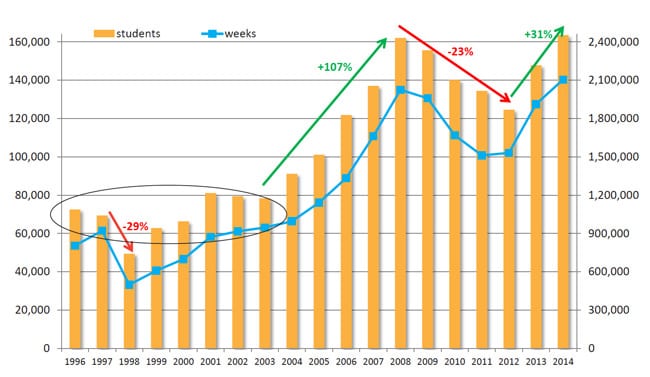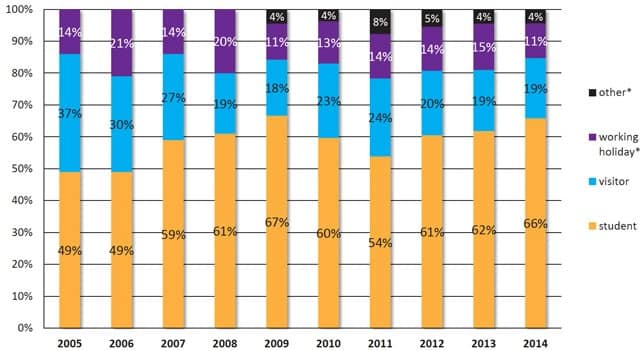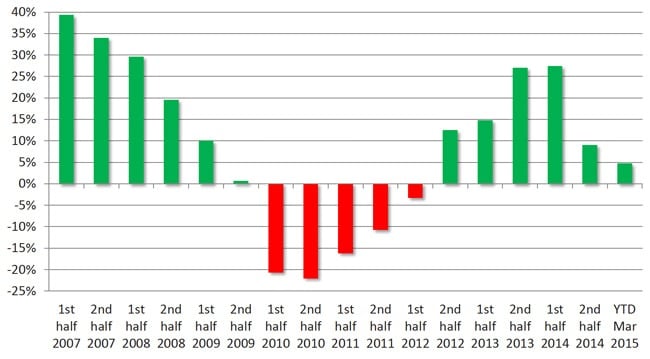Record-high English language enrolment in Australia
Australia’s surging ELICOS (English Language Intensive Courses for Overseas Students) sector saw another strong year of enrolment growth last year, and the latest data suggests the trend is continuing for 2015 as well.
The peak body English Australia reports that a total of 163,542 international students commenced English language programmes in Australia in 2014. That total surpassed the previous high from 2008 and represents a new enrolment record in the country.
The 2014 results mark another important step in Australia’s continuing recovery from recent-year declines in ELICOS numbers. The number of English language students in Australian programmes doubled in the five years from 2003 to 2008, but then declined by nearly a quarter (-23%) from 2009 to 2012.
The turnaround in ELICOS numbers – and in international enrolment in Australia generally – began in 2013 and has continued since. In fact, and as the following chart reflects, English language enrolment in Australia has grown 31% over the past two years alone.

- The number of students enrolled in Australian ELICOS programmes grew by 11% between 2013 and 2014;
- There was a 10% increase in student weeks;
- The sector recorded a 12% increase in export earnings to exceed AUS$2 billion (US$1.47 billion);
- While Australia continues to diversify its enrolment base, much of the growth in 2014 was driven by key markets in Asia, particularly China and India.
The average length of study for ELICOS students in Australia remained at 12.9 weeks in 2014. This was unchanged from the year before, and, also as in 2013, the growing percentage of English language students on student visas (as opposed to working holiday visas or other) played an important part in the overall length of study. Those on student visas, as could be expected, enrolled for longer study programmes – an average of 16.3 weeks in 2014 – whereas those on visitor or working holiday visas went to Australia for much shorter programmes (4.8 weeks and 8.1 weeks, respectively).
Pathways rejoice
As we noted last year, ELICOS enrolment growth is an important driver of overall student numbers in Australia. As a recent report from the Australian Department of Education and Training (DET) points out, "During their Australian education experience, the majority of international students undertake study in more than one educational sector. The English Language Intensive Courses for Overseas Students (ELICOS) sector is the first step in an Australian study pathway for nearly two-thirds [of] international students." DET reports that 65% of the international students who completed an ELICOS programme in 2013 went on directly to study in another sector in Australia. Just over a third (34%) continued on to higher education while nearly one in four (23%) entered a Vocational Education and Training (VET) programme. The other continuing students either entered non-award (5%) or secondary school (3%) programmes, while just over one third (35%) of ELICOS students did not pursue any further study in Australia. Executive Director Sue Blundell said of the 2014 ELICOS results, "The other sectors of international education look to English language enrolments as the vital first indicator of the health of international education as a whole. Pleasing as the growth is, however, it would be more sustainable if spread more evenly across all types of programmes/providers within the sector. Current government policy has favoured pathway programmes leading to higher education, with growth in these pathway students much stronger than the growth in students for stand-alone English language programmes."
Shifting visa status
We noted earlier that the visa status of ELICOS students in Australia has been shifting in recent years. The following chart illustrates this change, noting the increasing share of enrolment accounted for by those on student visas from 2011 on. The share of ELICOS enrolment accounted for by all other visa classes, in contrast, has declined between 2011 and 2014.

And on into 2015
Early DET data (year-to-date March 2015) indicates that Australian ELICOS numbers are off to a very promising start for the year. In fact, all international education sectors in Australia are showing growth again this year, with an overall increase of 9% over the same period for 2014.
ELICOS enrolment alone was up 4.6% YTD March 2015, and these year-to-date results represent the best performance for the sector since the previous peak year of 2009. However, it also seems clear that enrolment growth for Australian English language programmes is slowing over the better part of the last 12 months, particularly compared to the dramatic growth rates from 2012 through the first half of 2014.

















